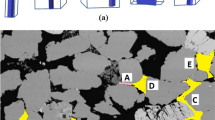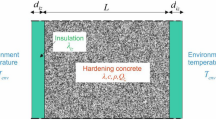Abstract
Evaporation tests in concrete columns have been analysed by numerical models to characterize the thermo-hydraulic properties and the processes in concrete. Two evaporation tests were performed: a column heated by a lamp and a column kept in room conditions. The conceptual model considers unsaturated liquid flow and transport of vapour and energy. We also calculated models that take into account the dissolved salts to study its effect on vapour pressure and evaporation. A retention curve has been obtained from relative humidity and gravimetric water content measured after dismantling the tests. The models have been calibrated by adjusting the model’s results to the measured data of water loss, relative humidity and temperature inside the concrete. The parameters obtained with the calibration are the permeability, thermal conductivity, boundary conditions and a tortuosity factor for vapour diffusion. Results show that the vapour diffusion is the dominant water transport process above an evaporation front, and liquid advection is dominant below it.











Similar content being viewed by others
Abbreviations
- \(A\) :
-
Constant for relative permeability
- \(a_\mathrm{w}\) :
-
Activity of water
- \(D\) :
-
Parameter for diffusion
- \(D_\mathrm{m}\) :
-
Molecular diffusion coefficient (m\(^{2}\) s\(^{-1}\))
- \(D^{\prime }_{\alpha }\) :
-
Mechanical dispersion coefficient (m\(^{2}\) s\(^{-1}\))
- \(d_\mathrm{l}\) :
-
Longitudinal dispersivity (m)
- \(E_{\alpha }\) :
-
Internal energy per unit of mass for each phase (J kg\(^{-1}\))
- \(E^\mathrm{i}_{\alpha }\) :
-
Specific internal energy (J kg\(^{-1}\))
- \(f\) :
-
External supply of component
- \(g\) :
-
Gravity (m s\(^{-2}\))
- HR:
-
Relative humidity
- \(i\) :
-
(superscript) Component index, w water, a dry air and h salt
- \(i_{\alpha }\) :
-
Diffusive or dispersive flux (J s\(^{-1}\) m\(^{-2}\))
- \(i_\mathrm{c}\) :
-
Heat conductive flux (J s\(^{-1}\) m\(^{-2}\))
- \(j^{i}_{\alpha }\) :
-
Mass flux of component in each phase (J s\(^{-1}\) m\(^{-2}\))
- \(j^\mathrm{w}_\mathrm{g}\) :
-
Vapour flux (kg s\(^{-1}\) m\(^{-2}\))
- \(j_\mathrm{e}\) :
-
Energy flux (J s\(^{-1}\) m\(^{-2}\))
- \(j^{0}_\mathrm{e}\) :
-
Radiation (J s\(^{-1}\) m\(^{-2}\))
- \(k_\mathrm{i}\) :
-
Intrinsic permeability (m\(^{2}\))
- \(k_\mathrm{r}\) :
-
Relative permeability
- \(M^{i}\) :
-
Molecular weight of component \(i\) (kg mol\(^{-1}\))
- \(m\) :
-
Shape parameter for retention curve
- \(n\) :
-
Parameter for relative permeability
- \(P_{\alpha }\) :
-
Pressure of phase \(\alpha \) (MPa)
- \(P^{i}_{\alpha }\) :
-
Partial pressure of component \(i\) in phase \(\alpha \) (MPa)
- \(P^{w}_\mathrm{g,sat}\) :
-
Saturated vapour pressure (MPa)
- \(P_{0}\) :
-
Entry pressure (MPa)
- \(P_{l0}\) :
-
Reference pressure (MPa)
- \(q_{\alpha }\) :
-
Flow rate (m s\(^{-1}\))
- \(R\) :
-
Ideal gas constant (J mol\(^{-1}\) K\(^{-1}\))
- \(S_{\alpha }\) :
-
Saturation of phase \(\alpha \)
- \(S_\mathrm{e}\) :
-
Effective water saturation
- \(T\) :
-
Temperature (\(^{\circ }\)C)
- \(T\) :
-
Gravimetric humidity
- \(\alpha \) :
-
(subscript) Phase index, l liquid, s solid and g gas
- \(\beta \) :
-
Compressibility (MPa\(^{-1}\))
- \(\beta _\mathrm{g}\) :
-
Boundary vapour exchange coefficient (m s\(^{-1}\))
- \(\gamma \) :
-
Solute variation coefficient
- \(\gamma _\mathrm{g}\) :
-
Boundary gas exchange coefficient (kg s\(^{-1}\) m\(^{-2}\) MPa\(^{-1}\))
- \(\gamma _\mathrm{e}\) :
-
Boundary heat exchange coefficient (J s\(^{-1}\) m\(^{-2}\) \(^{\circ }\)C\(^{-1}\))
- \(\epsilon \) :
-
Volumetric thermal expansion coefficient for liquid (\(^{\circ }\)C\(^{-1}\))
- \(\lambda \) :
-
Thermal conductivity (W m K\(^{-1}\))
- \(\mu _{\alpha }\) :
-
Viscosity of phase \(\alpha \) (MPa s)
- \(\theta _{\alpha }\) :
-
Volumetric phase content of \(\alpha \)
- \(\rho _{\alpha }\) :
-
Density of phase \(\alpha \) (kg m\(^{-3}\))
- \(\rho _{l0}\) :
-
Reference density of the liquid (kg m\(^{-3}\))
- \(\sigma _{l0}\) :
-
Surface tension at temperature \(T\) (N m\(^{-1}\))
- \(\tau \) :
-
Tortuosity
- \(\phi \) :
-
Porosity
- \(\omega ^{i}_{\alpha }\) :
-
Mass fraction of solute \(i\) in phase \(\alpha \) (kg kg\(^{-1}\))
References
Acero, P., Ayora, C., Carrera, J., Saaltink, M.W., Olivella, S.: Multiphase flow and reactive transport model in vadose tailings. Appl. Geochem. 24(7), 1238–1250 (2009). doi:10.1016/j.apgeochem.2009.03.008
Arya, S.P.: Introduction to micrometeorology, 2nd edn. Academic Press, San Diego, 420 pp (2001)
Baroghel-Bouny, V.: Water vapour sorption experiments on hardened cementitious materials: part I. Essential tool for analysis of hygral behaviour and its relation to pore structure. Cem. Concr. Res. 37(3), 414–437 (2007). doi:10.1016/j.cemconres.2006.11.019
Brue, F., Davy, C.A., Skoczylas, F., Burlion, N., Bourbon, X.: Effect of temperature on the water retention properties of two high performance concretes. Cem. Concr. Res. 42(2), 384–396 (2012). doi:10.1016/j.cemconres.2011.11.005
Carlier, J., Burlion, N.: Experimental and numerical assessment of the hydrodynamical properties of cementitious materials. Transp. Porous Media 86(1), 87–102 (2011). doi:10.1007/s11242-010-9607-7
Chen, W., Liu, J., Brue, F., Skoczylas, F., Davy, C.A., Bourbon, X., Talandier, J.: Water retention and gas relative permeability of two industrial concretes. Cem. Concr. Res. 42(7), 1001–1013 (2012). doi:10.1016/j.cemconres.2012.04.003
Gran, M., Carrera, J., Olivella, S., Saaltink, M.W.: Modeling evaporation processes in a saline soil from saturation to oven dry conditions. Hydrol. Earth Syst. Sci. 15(7), 2077–2089 (2011). doi:10.5194/hess-15-2077-2011
Grifoll, J., Gastó, J.M., Cohen, Y.: Non-isothermal soil water transport and evaporation. Adv. Water Resour. 28(11), 1254–1266 (2005). doi:10.1016/j.advwatres.2005.04.008
Ho, C.K., Webb, S.W.: Review of porous media enhanced vapor-phase diffusion mechanisms, models, and data—does enhanced vapor-phase diffusion exist? J. Porous Media 1(1), 71–92 (1998)
Khan, M.I.: Factors affecting the thermal properties of concrete and applicability of its prediction models. Build. Environ. 37(6), 607–614 (2002). doi:10.1016/S0360-1323(01)00061-0
Kim, K.H., Jeon, S.E., Kim, J.K., Yang, S.: An experimental study on thermal conductivity of concrete. Cem. Concr. Res. 33(3), 363–371 (2003). doi:10.1016/S0008-8846(02)00965-1
Leech, C., Lockington, D., Hooton, R.D.: Estimation of water retention curve from mercury intrusion porosimetry and van genuchten model. ACI Struct. J. 103(2), 291–295 (2006)
Lothenbach, B., Winnefeld, F.: Thermodynamic modelling of the hydration of portland cement. Cem. Concr. Res. 36(2), 209–226 (2006). doi:10.1016/j.cemconres.2005.03.001
Mainguy, M., Coussy, O., Baroghel-Bouny, V.: Role of air pressure in drying of weakly permeable materials. J. Eng. Mech. ASCE 127(6), 582–592 (2001). doi:10.1061/(ASCE)0733-9399(2001)127:6(582)
Marshall, A.L.: The thermal properties of concrete. Build. Sci. 7(3), 167–174 (1972). doi:10.1016/0007-3628(72)90022-9
Monlouis-Bonnaire, J.P., Verdier, J., Perrin, B.: Prediction of the relative permeability to gas flow of cement-based materials. Cem. Concr. Res. 34(5), 737–744 (2004). doi:10.1016/S0008-8846(03)00071-1
Olivella, S., Carrera, J., Gens, A., Alonso, E.E.: Non-isothermal multiphase flow of brine and gas through saline media. Transp. Porous Media 15, 271–293 (1994). doi:10.1016/0148-9062(95)93271-P
Olivella, S., Gens, A., Carrera, J., Alonso, E.E.: Numerical formulation for a simulator (code_bright) for the coupled analysis of saline media. Eng. Comput. 13(7), 87–112 (1996). doi:10.1108/02644409610151575
Pintado, X., Ledesma, A., Lloret, A.: Backanalysis of thermohydraulic bentonite properties from laboratory tests. Eng. Geol. 64(2–3), 91–115 (2002). doi:10.1016/S0013-7952(01)00110-7
Poyet, S.: Experimental investigation of the effect of temperature on the first desorption isotherm of concrete. Cem. Concr. Res. 39(11), 1052–1059 (2009). doi:10.1016/j.cemconres.2009.06.019
Poyet, S.: Determination of the intrinsic permeability to water of cementitious materials: influence of the water retention curve. Cem. Concr. Compos. 35(1), 127–135 (2013). doi:10.1016/j.cemconcomp.2012.08.023
S̆elih, J., Sousa, A.C.M., Bremner, T.W.: Moisture transport in initially fully saturated concrete during drying. Transp. Porous Media 24(1), 81–106 (1996). doi:10.1007/BF00175604
Van Genuchten, M.T.: A closed-form equation for predicting the hydraulic conductivity of unsaturated soils. Soil Sci. Soc. Am. J. 44(5), 892–898 (1980)
Villar, M.V., Martín, P.L., Barcala, J.M.: Caracterización del material de cobertera y el hormigón del C.A. El Cabril. Technical report CIEMAT/DMA/2G205/03/09, CIEMAT, Madrid, 55 pp (2009)
Villar, M.V., Martín, P.L., Romero, F.J., Gutiérrez-Rodrigo, V., Barcala, J.M.: Gas and Water Permeability of Concrete. Informes técnicos CIEMAT 1261, CIEMAT, Madrid, 45 pp (2012)
Villar, M.V., Romero, F.J.: Determination of water retention curves of concrete. In: 2nd International Symposium on Cement-Based Materials for Nuclear Waste (NUWCEM), Avignon, France, pp. 1–9 (2014)
Wardeh, G., Perrin, B.: Relative permeabilities of cement-based materials: influence of the tortuosity function. J. Build. Phys. 30(1), 39–57 (2006). doi:10.1177/1744259106064597
Wu, M., Johannesson, B., Geiker, M.: A study of the water vapor sorption isotherms of hardened cement pastes: possible pore structure changes at low relative humidity and the impact of temperature on isotherms. Cem. Concr. Res. 56, 97–105 (2014). doi:10.1016/j.cemconres.2013.11.008
Acknowledgments
This work was funded by ENRESA (Spanish Nuclear Waste Management Company) and a Research Grant from the Technical University of Catalonia (UPC).
Author information
Authors and Affiliations
Corresponding author
Appendix: Constitutive Laws
Appendix: Constitutive Laws
1.1 Definition Constraints
1.1.1 Mass fractions
1.1.2 Volumetric content
1.1.3 Saturations
1.1.4 Partial pressures
1.2 Equilibrium Constraints
1.2.1 Vapour–liquid water (psychrometric law)
where \(M^\mathrm{h}\) = 49.37 g mol\(^{-1}\)
1.2.2 Dissolved-gaseous air (Henry’s law)
1.3 Phase and Interphase Properties
1.3.1 Retention curve (van Genuchten law)
where \(P_{0}=7.7\) Mpa, \(m=0.34\), \(\sigma _{T}\) is the surface tension at temperature T and \(\sigma _{0}=0.072\) N m\(^{-1}\) at 20 \(^{\circ }\)C.
1.3.2 Relative permeability
where \(A=0.01\) and \(n=7\)
where \(A=1\) and \(n=3\).
1.3.3 Properties of liquid
where \(\rho _{l0}=1002.6\) kg m\(^{-1}\), \(P_{l0}=0.1\,\hbox {MPa}\), \(\beta =4.5\times 10^{-4}\) MPa\(^{-1}\), \(\gamma =0.6923\) and \(\epsilon =3.4\times 10^{-4}\,^{\circ }\)C\(^{-1}\)
where \(E^\mathrm{w}_\mathrm{l}=4184\) T J kg\(^{-1}\) and \(E^\mathrm{a}_\mathrm{l}=1000T\) J kg\(^{-1}\).
1.3.4 Properties of gas
where \(M^\mathrm{a}_\mathrm{g}=0.02895\) kg mol\(^{-1}\) and H \(=\) 10,000 MPa
where \(E^\mathrm{w}_\mathrm{g}=2.5 \times 10^{6}+1900T\) J kg\(^{-1}\) and \(E^\mathrm{a}_\mathrm{g} =1000T\) J kg\(^{-1}\).
1.3.5 Properties of solid
The density of the solid phase (\(\rho _\mathrm{s}\)) is 2360 kg m\(^{-1}\) and \(E_\mathrm{s} =780T\) J kg\(^{-1}\).
1.4 Fluxes
1.4.1 Darcy’s flux
where \(k_\mathrm{i}=4.2 \times 10^{-18}\) m\(^{2}\).
1.4.2 Diffusive flux (Fick’s law)
where \(\tau _\mathrm{non{\text {-}}heated}=0.08\) and \(\tau _\mathrm{heated}=0.3\)
where \(D=5.9 \times 10^{-6}\) m s\(^{-1}\) K\(^{-n}\) Pa and \(n=2.3\)
where \(D=1.1 \times 10^{-4}\) m\(^{2}\) s\(^{-1}\).
1.4.3 Dispersive flux (Fick’s law)
where \(d_\mathrm{l}=0.015\) m.
1.4.4 Mass flux
1.4.5 Conductive flux of heat (Fourier’s law)
where \(\lambda _\mathrm{sat}=1.14\) W m K\(^{-1}\) and \(\lambda _\mathrm{dry}=0.66\) W m K\(^{-1}\).
1.4.6 Advective flux of heat
Rights and permissions
About this article
Cite this article
Chaparro, M.C., Saaltink, M.W. & Villar, M.V. Characterization of Concrete by Calibrating Thermo-Hydraulic Multiphase Flow Models. Transp Porous Med 109, 147–167 (2015). https://doi.org/10.1007/s11242-015-0506-9
Received:
Accepted:
Published:
Issue Date:
DOI: https://doi.org/10.1007/s11242-015-0506-9




